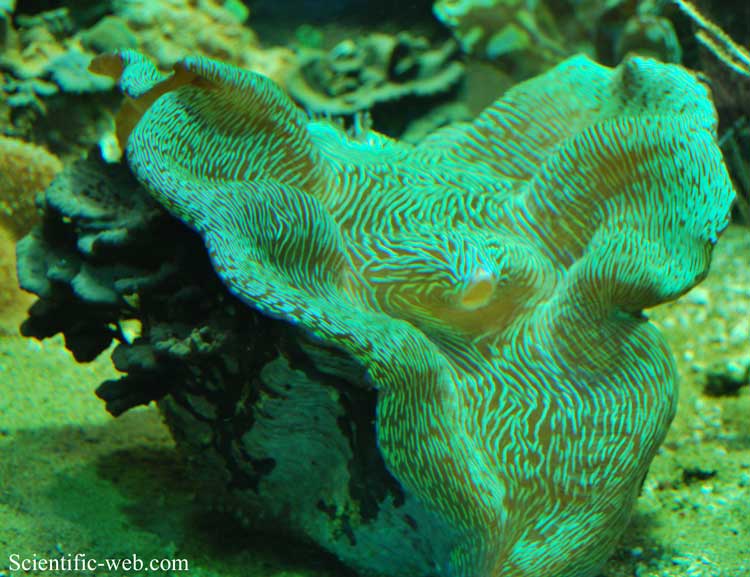
Tridacna squamosa, Photo: Michael Lahanas
Superregnum: Eukaryota
Cladus: Unikonta
Cladus: Opisthokonta
Cladus: Holozoa
Regnum: Animalia
Subregnum: Eumetazoa
Cladus: Bilateria
Cladus: Nephrozoa
Cladus: Protostomia
Cladus: Spiralia
Cladus: Lophotrochozoa
Phylum: Mollusca
Classis: Bivalvia
Subclassis: Heterodonta
Ordo: Veneroida
Superfamilia: Cardioidea
Familia: Cardiidae
Subfamilia: Tridacninae
Genus: Tridacna
Subgenus: Tridacna (Chametrachea)
Species: Tridacna squamosa
Name
Tridacna squamosa Lamarck, 1819
References
Links
Tridacna squamosa in the World Register of Marine Species
Vernacular names
English: Fluted giant clam, giant clam
magyar: Pikkelyes óriáskagyló
日本語: ヒレシャコガイ
ไทย: หอยมือเสือเล็บยาว, หอยมือเสือเกล็ด
Tridacna squamosa, known commonly as the fluted giant clam and scaly clam, is a species of bivalve in the family Cardiidae. [1] [3]
It is one of a number of large clam species native to the shallow coral reefs of the South Pacific and Indian Oceans. It is distinguished by the large, leaf-like fluted edges on its shell called 'scutes' and a byssal opening that is small compared to those of other members of the subfamily Tridacnindae. Normal coloration of the mantle ranges from browns and purples to greens and yellows arranged in elongated linear or spot-like patterns. Tridacna squamosa grows to 40 centimetres (16 in) across.
Sessile in adulthood, the clam's mantle tissues act as a habitat for the symbiotic single-celled dinoflagellate algae (zooxanthellae) from which it gets a major portion of its nutrition. By day, the clam spreads out its mantle tissue so that the algae receive the sunlight they need to photosynthesize.
Range
The native range spans from South Africa to the Red Sea and to the Marshall Islands.
In captivity
Tridacna squamosa is sometimes kept in aquaria, where it requires a moderate amount of care. This species is a relatively hardy member of the Tridacnidae.
A moderate amount of light is required by this species because it relies on zooxanthellae for part of its nutrition. These dinoflagellates use the mantle as a habitat. However, it is not nearly as dependent on this photosynthesis as other tridacnids such as Tridacna crocea or T. maxima, and it also consumes phytoplankton to complete its diet.
Tridacna squamosa is a peaceful resident and does not harm other organisms, in the wild or otherwise. Despite its ability to shut completely, anemones, triggerfish and puffers may be predators in a domestic environment. It is also recommended that they not be kept with anemones as the anemone may move close to the clam and sting or eat it. Clams should be inspected for Pyramidellidae snails and quarantined, if possible, before being added to aquaria.
In aquaria, it should be kept lower in the display and although some specimens prefer lying in the substrate they will occasionally attach their byssal threads to rocks above the substrate.
All clams require good to excellent water quality, but may help reduce nitrate levels in a system. Clams are noted to consume free nitrates to a degree.
Conservation status
The IUCN lists this clam as lower risk, but dependent on conservation efforts.[1] The species is listed in Appendix II of the Convention on International Trade in Endangered Species (CITES) meaning international trade (including in parts and derivatives) is regulated.[2]
References
Wells, S. (1996). "Tridacna squamosa". IUCN Red List of Threatened Species. 1996: e.T22140A9362870. doi:10.2305/IUCN.UK.1996.RLTS.T22140A9362870.en. Retrieved 20 November 2021.
"Appendices | CITES". cites.org. Retrieved 2022-01-14.
MolluscaBase eds. (2022). MolluscaBase. Tridacna squamosa Lamarck, 1819. Accessed through: World Register of Marine Species at: https://marinespecies.org/aphia.php?p=taxdetails&id=207674 on 2022-10-13
Rosewater, J. (1965). The family Tridacnidae in the Indo-Pacific. Indo-Pacific Mollusca 1(6): 347-408
Steyn, D.G. & Lussi, M. (1998) Marine Shells of South Africa. An Illustrated Collector's Guide to Beached Shells. Ekogilde Publishers, Hartebeespoort, South Africa, ii + 264 pp.
Rosenberg, G. 1992. Encyclopedia of Seashells. Dorset: New York. 224 pp
Liu, J.Y. [Ruiyu] (ed.). (2008). Checklist of marine biota of China seas. China Science Press. 1267 pp
Branch, G.M., Griffiths, C.L., Branch, M.L. & Beckley, L.E. (2010). Two Oceans. A guide to the marine life of southern Africa. Revised edition. David Philip: Cape Town.
Retrieved from "http://en.wikipedia.org/"
All text is available under the terms of the GNU Free Documentation License

